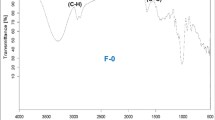Abstract
Many waxes including plant waxes and animal waxes were evaluated for the gelation ability toward soybean oil (SBO) and compared with hydrogenated vegetable oils, petroleum waxes and commercial non-edible gelling agents to understand factors affecting the gelation ability of a gelator. Sunflower wax (SW) showed the most promising results and all SW samples from three different suppliers could make a gel with concentrations as low as 0.5 wt%. Candelilla wax and rice bran wax also showed good gelation properties, which, however, varied with different suppliers. Gelation ability of a wax is significantly dependant on its purity and detailed composition. A wax ester with longer alkyl chains has significantly better gelation ability toward SBO than that with shorter alkyl chains indicating that the chain length of a component in a wax such as wax ester is an important factor for gelation ability. The SW–SBO organogel showed increased melting point with increased SW content, showing the melting point range from about 47 to 65 °C with 0.5–10 wt% SW. The effects of cooling rate on crystal size and firmness of a gel were investigated. The dependence of firmness on cooling rate was so significant that the desired texture of an organogel could be achieved by controlling the cooling rate in addition to controlling the amount of gelling agent. This research reveals that a small amount of food grade plant waxes including SW may replace a large amount of the hardstock containing trans-fat or saturated fat.





Similar content being viewed by others
References
Gebauer SK, Psota TL, Kris-Etherton PM (2007) The diversity of health effects of individual trans fatty acid isomers. Lipids 42:787–799
Micha R, Mozaffarian D (2010) Saturated fat and cardiometabolic risk factors, coronary heart disease, stroke, and diabetes: a fresh look at the evidence. Lipids 45:893–905
Abdallah DJ, Lu L, Weiss RG (1999) Thermoreversible organogels from alkane gelators with one heteroatom. Chem Mater 11:2907–2911
Wright AJ, Marangoni AG (2007) Time, temperature, and concentration dependence of ricinelaidic acid–canola oil organogelation. J Am Oil Chem Soc 84:3–9
Rogers MA, Wright AJ, Marangoni AG (2009) Nanostructuring fiber morphology and solvent inclusions in 12-hydroxystearic acid/canola oil organogels. Curr Opin Colloid Interface Sci 14:33–42
Marangoni AG, Garti N (2011) Edible oleogels: structure and health implication. AOCS Press, Urbana
Toro-Vazquez JF, Morales-Rueda JA, Dibildox-Alvarado E, Charo-Alonso M, Alonzo-Macias M, Gonzalez-Chavez MM (2007) Thermal and textural properties of organogels developed by candelilla wax in safflower oil. J Am Oil Chem Soc 84:989–1000
Morales-Rueda JA, Dibildox-Alvarado E, Charo-Alonso MA, Weiss RG, Toro-Vazquez JF (2009) Thermo-mechanical properties of candelilla wax and dotriacontane organogels in safflower oil. Eur J Lipid Sci Technol 111:207–215
Dassanayake LSK, Kodali DR, Ueno S, Sato K (2009) Physical properties of rice bran wax in bulk and organogels. J Am Oil Chem Soc 86:1163–1173
Martini S, Carelli AA, Lee J (2008) Effect of the addition of waxes on the crystallization behavior of anhydrous milk fat. J Am Oil Chem Soc 85:1097–1104
Daniel J, Rajasekharan R (2003) Organogelation of plant oils and hydrocarbons by long-chain saturated FA, fatty alcohols, wax esters, and dicarboxylic acids. J Am Oil Chem Soc 80:417–421
Foreign Agricultural Service (2011) United States Department of Agriculture. Table 3: major vegetable oils: world supply and distribution. http://www.fas.usda.gov/oilseeds/Current/default.asp. Accessed July 2011
Kanya TCS, Rao LJ, Sastry MCS (2007) Characterization of wax esters, free fatty alcohols and free fatty acids of crude wax from sunflower seed oil refineries. Food Chem 101:1552–1557
Vandenburg LE, Wilder EA (1970) The structural constituents of carnauba wax. J Am Oil Chem Soc 47:514–518
Vali SR, Ju YH, Kaimal TNB, Chern YT (2005) A process for the preparation of food-grade rice bran wax and the determination of its composition. J Am Oil Chem Soc 82:57–64
Miwa TK (1984) Structural determination and uses of jojoba oil. J Am Oil Chem Soc 61:407–410
Parkash S (2010) Petroleum fuels manufacturing handbook: including specialty products and sustainable manufacturing techniques. McGraw–Hill, New York
Tulloch AP (1970) The composition of beeswax and other waxes secreted by insects. Lipids 5:247–258
Schuette HA, Christenson RM (1942) The saturated fatty acids of Japan wax. Oil Soap 19:209–211
Chen HC, Kuo CH, Chen HH, Liu Y-C, Shieh CJ (2011) Optimization of enzymatic synthesis of cetyl 2-ethylhexanoate by Novozym® 435. J Am Oil Chem Soc. doi:10.1007/s11746-011-1868-y
Guth H, Grosch W (1997) Stability of furanoid fatty acids in soybean oil. J Am Oil Chem Soc 74:323–326
Miyake Y, Yokomizo K, Matsuzaki N (1998) Rapid determination of iodine value by 1H nuclear magnetic resonance spectroscopy. J Am Oil Chem Soc 75:15–19
Morales-Rueda JA, Dibildox-Alvarado E, Charo-Alonso MA, Toro-Vazquez JF (2009) Rheological properties of candelilla wax and dotriacontane organogels measured with a true-gap system. J Am Oil Chem Soc 86:765–772
Vintiloiu A, Leroux JC (2008) Organogels and their use in drug delivery—a review. J Control Release 125:179–192
Acknowledgments
The authors would like to express appreciation to Lynne Copes for excellent technical work and to Dr. Karl Vermillion for NMR spectra and technical information.
Author information
Authors and Affiliations
Corresponding author
Additional information
Mention of trade names or commercial products in this article is solely for the purpose of providing scientific information and does not imply recommendation or endorsement by the US Department of Agriculture. USDA is an equal opportunity provider and employer.
About this article
Cite this article
Hwang, HS., Kim, S., Singh, M. et al. Organogel Formation of Soybean Oil with Waxes. J Am Oil Chem Soc 89, 639–647 (2012). https://doi.org/10.1007/s11746-011-1953-2
Received:
Revised:
Accepted:
Published:
Issue Date:
DOI: https://doi.org/10.1007/s11746-011-1953-2




